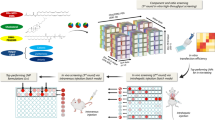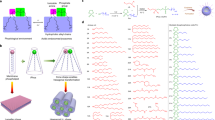Abstract
We have previously demonstrated that liposomes generated from poly(cationic lipid) (PCL) and cholesterol (Chol) have low cytotoxicity, are serum resistant, and display a transfection efficiency in vitro similar to commercially available cationic liposomes. Our in vivo experiments demonstrated that PCL–Chol liposomes bound much less avidly to serum proteins than did liposomes composed of 1,2-bis(dioleoyloxy)-3-(trimethylamonio)propane (DOTAP)–Chol or DOTAP–L-α dioleoyl phosphatidylethanolamine (DOPE). Injection of the lipoplexes (PCL–Chol+DNA) through the portal vein after partial hepatectomy (PH) led to much higher reporter gene expression (luciferase) in the liver than did naked DNA injection. Marked green fluorescent protein expression was visualized in almost all hepatocytes in the liver of mice receiving lipoplex injection, even in the absence of PH. Subcutaneous injection of thyroid hormone triiodothyromine (T3) significantly promoted hepatocyte regeneration and markedly enhanced PCL–Chol-mediated gene transfer in mouse liver when the lipoplex was administrated through either portal or tail vein. With T3 pretreatment, PCL–Chol exerted a better gene transfer efficacy in mouse liver than DOTAP–Chol or DOTAP–DOPE. Two injections of lipoplexes through an indwelling catheter in the portal vein extended the transgene expression at a high level when T3 injection was repeated. In conclusion, our findings demonstrate that the polymerized cationic liposomes are very stable in the blood and are effective agents for in vivo gene delivery, and that thyroid hormone administration offers a non-invasive approach to enhance liposome-mediated liver gene delivery.
This is a preview of subscription content, access via your institution
Access options
Subscribe to this journal
Receive 12 print issues and online access
$259.00 per year
only $21.58 per issue
Buy this article
- Purchase on Springer Link
- Instant access to full article PDF
Prices may be subject to local taxes which are calculated during checkout







Similar content being viewed by others
References
Nishikawa M, Huang L . Nonviral vectors in the new milennium: delivery barriers in gene transfer. Hum Gene Ther 2001; 12: 861–870.
Templeton NS et al. Improved DNA:liposome complexes for increased systemic delivery and gene expression. Nat Biotechnol 1997; 15: 647–652.
Ramesh R et al. Successful treatment of primary and disseminated human lung cancers by systemic delivery of tumor suppressor genes using an improved liposome vector. Mol Ther 2001; 3: 337–350.
Mohr L et al. Cationic liposome-mediated gene delivery to the liver and to hepatocellular carcinomas in mice. Hum Gene Ther 2001; 12: 799–809.
Saravolac EG et al. Encapsulation of plasmid DNA in stabilized plasmid-lipid particles composed of different cationic lipid concentration for optimal transfection activity. J Drug Targeting 2000; 7: 423–437.
Gao X, Huang L . Potentiation of cationic liposome-mediated gene delivery by polycations. Biochemistry 1996; 35: 1027–1036.
Choi YH et al. Characterization of a targeted gene carrier, lactose-polyethylene glycol-grafted poly-L-lysine, and its complexes with plasmid DNA. Hum Gene Ther 1999; 10: 2657–2665.
Zanta MA, Boussif O, Adib A, Behr JP . In vitro gene delivery to hepatocytes with galactosylated polyethyleneimine. Bioconj Chem 1997; 8: 839–844.
Zheng J, Manuel WS, Hornsby PJ . Transfection of cells mediated by biodegradable polymer materials with surface-bound polyethyleneimine. Biotechnol Prog 2000; 16: 254–257.
van de Wetering P, Schuurmans-Nieuwenbroek NME, Hennink WE, Storm G . Comparative transfection studies of human ovarian carcinoma cells in vitro, ex vivo and in vivo with poly(2-(dimethylamino)ethyl methacrylate)-base polyplexes. J Gene Med 1999; 1: 156–165.
Haensler J, Szoka FC . Polyamidoamine cascade polymers mediate efficient transfection of cells in culture. Bionconj Chem 1993; 4: 372–379.
Bielinska AU, Chen C, Johnson J, Baker JR . DNA complexing with polyamidoamine dendrimers: implications for transfection. Bioconj Chem 1999; 10: 843–850.
Lizarzaburu ME, Kurth MJ, Nantz MH . Preparation of stable vesicles from a preformed poly(acrylic lipid): synthesis of novel DNA delivery agents (submitted for publication).
Wu J et al. Cationic lipid polymerization as a novel approach for constructing new DNA delivery agents. Bioconj Chem 2001; 12: 251–257.
Sakurai F et al. Interaction between DNA–cationic liposome complexes and erythrocytes is an important factor in systemic gene transfer via the intravenous route in mice: the role of the neutral helper lipid. Gene Ther 2001; 8: 677–686.
Wu J, Nantz MH, Zern MA . Targeting hepatocytes for drug and gene delivery – emerging novel approaches and applications. Front Biosci 2002; 7: d717-d725.
Hwang SH, Hayashi K, Takayama K, Maitani Y . Liver-targeted gene transfer into a human hepatoblastoma cell line and in vivo by sterylglucoside-containing cationic liposomes. Gene Ther 2001; 8: 1276–1280.
Bucher NLR, Farmer SR . Liver regeneration following partial hepatectomy: genes and metabolism. In: Stain A, Deihl AM (ed). Liver Growth and Repair. Chapman & Hall: London, 1998, pp. 1–27.
Feldherr CM, Akin D . The permeability of the nuclear envelope in dividing and non-dividing cell cultures. J Cell Biol 1990; 111: 1–8.
Grossman M et al. A pilot study of ex vivo gene therapy for homozygous familial hypercholesterolaemia. Nat Med 1995; 1: 1148–1154.
Francavilla A et al. Hepatocyte proliferation and gene expression induced by triiodothyronine in vivo and in vitro. Hepatology 1994; 20: 1237–1241.
Oren R et al. Role of thyroid hormone in stimulating liver repopulation in the rat by transplanted hepatocytes. Hepatology 1999; 30: 903–913.
Forbes SJ et al. Synergistic growth factors enhance rat liver proliferation and enable retroviral gene transfer via a peripheral vein. Gastroenterology 2000; 118: 591–598.
Demori I et al. Tri-iodothyronine increases insulin-like growth factor binding protein-4 expression in rat hepatocytes. J Endocrinol 1997; 154: 155–165.
Pibiri M et al. Cyclin D1 is an early target in hepatocyte proliferation induced by thyroid hormone (T3). FASEB J 2001; 15: 1006–1013.
Duan Y-Y et al. Initial steps in the bifunctional gene therapy of α1-antitrypsin deficiency. Hepatology 2001; 34: 212A.
Hecker JG, Hall Leon L, Irion VR . Nonviral gene delivery to the lateral ventricles in rat brain: initial evidence for widespread distribution and expression in the central nervous system. Mol Ther 2001; 3: 375–384.
Wu J et al. Increased liver up-take of liposomes and improved targeting efficacy by labeling with asialofetuin in rodents. Hepatology 1998; 27: 772–778.
Peeters MJV, Lieber A, Perkins J, Kay MA . Methods for multiple portal infusions in mice: quantitation of adeno-virus-mediated hepatic gene transfer. Biotechniques 1996; 20: 278–282.
Frederiks WM et al. Immunocytochemical determination of ploidy class-dependent bromodeoxyuridine incorporation in rat liver parenchymal cells after partial hepatectomy. Histochemistry 1990; 93: 627–630.
Song YK, Liu F, Chu S, Liu DX . Characterization of cationic liposome-mediated gene transfer in vivo by intravenous administration. Hum Gene Ther 1997; 8: 1585–1594.
Acknowledgements
This work was supported by grants from the Cystic Fibrosis Foundation to MHN, NIH (AA-06386) to MAZ, and by a Liver Scholar Award from the American Liver Foundation and a UC Davis Health System Award to JW. Part of this work was presented at the fifth Annual Meeting of the American Society of Gene Therapy (ASGT), June 5–9, 2002, Boston, MA, USA and published in abstract form in Molecular Therapy 2002; 5: S11 and S73.
Author information
Authors and Affiliations
Rights and permissions
About this article
Cite this article
Liu, L., Zern, M., Lizarzaburu, M. et al. Poly(cationic lipid)-mediated in vivo gene delivery to mouse liver. Gene Ther 10, 180–187 (2003). https://doi.org/10.1038/sj.gt.3301861
Received:
Accepted:
Published:
Issue Date:
DOI: https://doi.org/10.1038/sj.gt.3301861
Keywords
This article is cited by
-
A versatile transposon-based technology to generate loss- and gain-of-function phenotypes in the mouse liver
BMC Biology (2022)
-
Liposome-based transfection enhances RNAi and CRISPR-mediated mutagenesis in non-model nematode systems
Scientific Reports (2019)
-
Hedgehog signaling pathway affects the sensitivity of hepatoma cells to drug therapy through the ABCC1 transporter
Laboratory Investigation (2017)
-
Aberrant hedgehog signaling is responsible for the highly invasive behavior of a subpopulation of hepatoma cells
Oncogene (2016)
-
A Potential Targeting Gene Vector Based on Biotinylated Polyethyleneimine/Avidin Bioconjugates
Pharmaceutical Research (2009)



